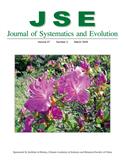Shuang-Xing GUO, Jin-Geng SHA, Li-Zeng BIAN, Yin-Long QIU
A fossil with Gnetum affinity was found in the Jianshangou Member (Barremian Age) of the Yixian Formation (Lower Cretaceous Epoch) of the Jehol Group in western Liaoning, northeastern China. The single fossil specimen is represented by both elongate-cylindrical male spike strobiles which borne within a nodal bract of cauliflorous branch. The spike strobiles have apparent nodes, invisible internodes, and numerous verticillate involucral collars. The microsporangiate units within involucral collars are not seen. The male spike strobiles with verticillate involucral collars occur exclusively in Gnetum; hence, the fossil strobiles are attributed to a new taxon, Khitania columnispicata gen. & sp. nov., being closely related to Gnetum. The general isotopic dating suggests an age of Barremian, ca. 125–122 million years (Myr) ago for the Jianshangou Member. The palaeoecological and palaeoclimatic inference based on the compositions of flora and fauna, and lithological characters of the fossil locality suggests that the fossil plants grew in a subtropical mesophytic forest and under a warmer climate. The remains of male spike strobiles are the first record of gnetalean macrofossil. It documents the evolution of the distinct gnetoid morphology and indicates a wider range of distribution of Gnetaceae in the Early Cretaceous than present day.

